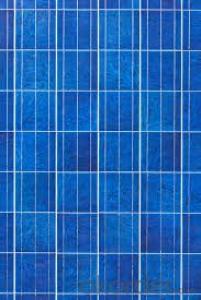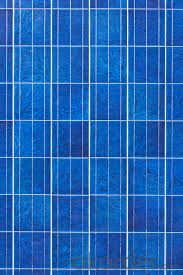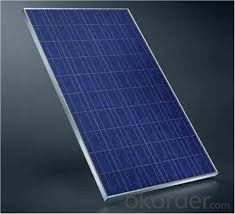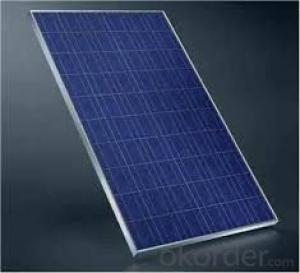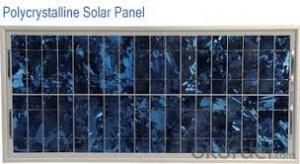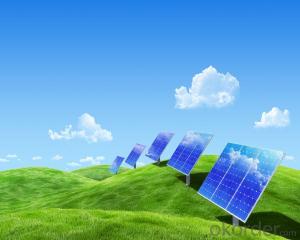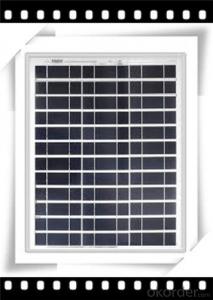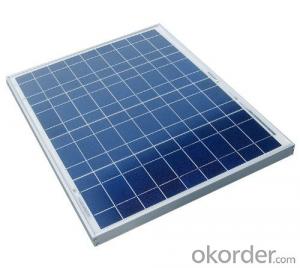4.0 Solar Cells Mini 0.45w Poly Solar Panel with 25 Years Warranty CNBM
- Loading Port:
- Qingdao
- Payment Terms:
- TT OR LC
- Min Order Qty:
- 10 set
- Supply Capability:
- 300000 set/month
OKorder Service Pledge
OKorder Financial Service
You Might Also Like
Polycrystalline Solar Modules
CNBM offers a range of small, medium and large polycrystalline solar modules, designed for a range of requirements.
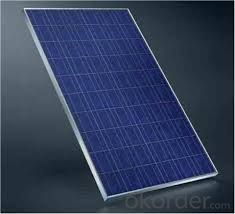
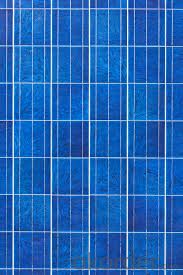
Specifications:
Tolerance | +/-3% |
Cell | Polycrystalline silicon solar cells (156 x 156mm) |
N0. of Cells | 60 (10 x 6) |
Dimension of Modules (mm) | 1650 x 990 x 40 |
Weight (kg) | 25.5 |
Limits:
Operating Temperature | -40~+85? |
Storage Temperature | -40~+85? |
Maximum System Voltage | 1000 VDC max. |
Hail Impact | Diameter of 28mm with impact speed |
Temperature and Coefficients:
NOCT | 48C+/-2? |
Voltage temperature coefficient (%/K) | -0.35 |
Current temperature coefficient (%/K) | 0.05 |
Power temperature coefficient (%/K) | -0.45 |
Characteristics:
Model: | SGM-200P | SGM-210P | SGM-220P |
Max-power voltage Vmp (V) | 29.2 | 29.4 | 29.41 |
Max-power current Imp (A) | 6.85 | 7.14 | 7.48 |
Open-circuit voltage Voc (V) | 36.5 | 36.69 | 36.9 |
Short-Circuit Current Isc (A) | 7.28 | 7.6 | 7.93 |
Max-power Pm(W) | 200 | 210 | 220 |
Model: | SGM-230P |
Max-power voltage Vmp (V) | 29.8 |
Max-power current Imp (A) | 7.72 |
Open-circuit voltage Voc (V) | 37.31 |
Short-Circuit Current Isc (A) | 8.19 |
Max-power Pm(W) | 230 |
STC: Irradiance 1000W/m2, module temperature 25?, AM-=1.5
Poly Crystalline Solar Panels Specifications Range
Maximum Power (Pm) | Dimension | Weight | Operating Voltage (Vmp) | Operating Current (Imp) | Open Circuit Voltage (Voc) | Short Circuit Current (Isc) |
0.45W | 140x80x10mm | 0.08kg | 3.3V | 150mA | 4.6V | 160mA |
1.0W | 162x140x10mm | 0.16kg | 7.5V | 150mA | 10.3V | 160mA |
4.5W | 269x251x23mm | 0.8kg | 16.5V | 0.27A | 20.5V | 0.3A |
10W | 420.1×268.9×22.6mm | 1.92kg | 17.5V | 0.58A | 20.5V | 0.6A |
20W | 425x502x50mm | 3.0kg | 16.8V | 1.19A | 21.0V | 1.29A |
30W | 593x502x22.6mm | 3.9kg | 16.8V | 1.78A | 21.0V | 1.94A |
40W | 655x537x50mm | 5.75kg | 17.3V | 2.31A | 22.1V | 2.54A |
50W | 839x537x50mm | 6.0kg | 17.5V | 2.9A | 21.8V | 3.17A |
65W | 1111x502x50mm | 7.2kg | 17.6V | 3.69A | 22.1V | 3.99A |
80W | 1204x537x50mm | 7.7kg | 17.6V | 4.55A | 22.1V | 4.8A |
- Q: Can solar cells be used in water desalination?
- Yes, solar cells can be used in water desalination. Solar energy can be harnessed by solar cells to power desalination processes such as reverse osmosis or distillation, providing a sustainable and renewable source of energy for converting saltwater into freshwater.
- Q: Where and how can I find more information of Photovoltaic Cells Solar Panels? Can anybody share more about that?
- Photovoltaic Cells is the electricity from sunlight, you can find a lot more than what I listed for you here from the website such as www.dasolar
- Q: How do solar cells perform in areas with high winds?
- Solar cells can perform well in areas with high winds as long as they are properly installed and secured. However, excessive wind speeds can potentially damage or displace the solar panels, affecting their efficiency. To mitigate this, appropriate mounting systems and anchoring techniques can be used to ensure the stability and durability of solar installations in windy areas.
- Q: What do the solar cell suppliers provide once we purchase the order from the solar cells from them.
- The good solar cells suppliers do not only sell you the solar cells products, they also give you very useful suggestions to help you install it.
- Q: What are the environmental impacts of solar cell production?
- The environmental impacts of solar cell production include the extraction and processing of raw materials, such as silicon, which can contribute to habitat destruction and water pollution. The manufacturing process itself requires energy and generates greenhouse gas emissions. Additionally, the disposal of old or damaged solar cells can pose challenges due to their composition and potential for toxic waste. However, when compared to the environmental impacts of fossil fuel-based energy production, solar cell production is generally considered to be much less harmful.
- Q: Can solar cells be used in industrial applications?
- Yes, solar cells can be used in industrial applications. They are increasingly being integrated into industrial processes to generate clean and renewable energy for powering machinery, equipment, and facilities. Solar cells are utilized in various industrial sectors such as manufacturing, agriculture, mining, and logistics, contributing to reduced carbon emissions and operational costs.
- Q: Can solar cells be used to power electric vehicles?
- Yes, solar cells can be used to power electric vehicles. Solar panels can be installed on the roof or body of an electric vehicle to capture sunlight and convert it into electricity, which can then be used to charge the vehicle's batteries. This allows the vehicle to be partially or fully powered by solar energy, reducing reliance on traditional charging methods and promoting sustainability. However, the efficiency of solar cells and the limited surface area available on vehicles may currently limit their ability to solely power electric vehicles, but they can certainly contribute to extending their range and reducing their carbon footprint.
- Q: Can solar cells be used in mining or extraction operations?
- Yes, solar cells can be used in mining or extraction operations. They can be employed to power various equipment and machinery used in these operations, such as lighting systems, ventilation systems, and pumps, reducing the reliance on fossil fuel-based energy sources. Additionally, solar cells can also be utilized to provide electricity to remote mining sites where grid connections are not feasible, thereby reducing the environmental impact and operational costs associated with these operations.
- Q: How do monocrystalline solar cells differ from polycrystalline solar cells?
- Monocrystalline solar cells are made from a single crystal structure, resulting in a uniform dark color and higher efficiency. On the other hand, polycrystalline solar cells are made from multiple crystal structures, giving them a speckled appearance and slightly lower efficiency.
- Q: How does a solar cell work?
- A solar cell works by converting sunlight into electricity through the photovoltaic effect. It consists of a thin semiconductor material, usually silicon, which absorbs photons from sunlight. When the photons strike the semiconductor material, they transfer their energy to the electrons in the material, causing them to become excited and move freely. This creates a flow of electrons, known as an electric current. The solar cell contains two layers, one with excess electrons (n-type) and the other with a deficiency of electrons (p-type), creating an electric field. As the excited electrons move towards the p-n junction, the electric field forces them to move in one direction, resulting in a usable electric current. This current can be harnessed and used to power various devices or stored in batteries for later use.
Send your message to us
4.0 Solar Cells Mini 0.45w Poly Solar Panel with 25 Years Warranty CNBM
- Loading Port:
- Qingdao
- Payment Terms:
- TT OR LC
- Min Order Qty:
- 10 set
- Supply Capability:
- 300000 set/month
OKorder Service Pledge
OKorder Financial Service
Similar products
Hot products
Hot Searches
Related keywords
